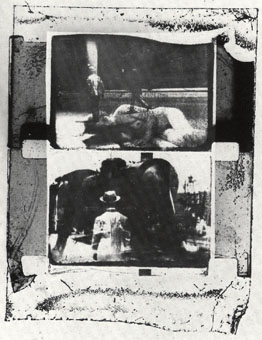"Anonimatografo" 1972
Film 16 mm bianco e nero, sonoro, 24 ftg/s, 30'
(dedicato ad Alberto Farassino)
Anonimatografo. Questo film è stato girato a passo-uno e realizzato con durissimi avvicinamenti ottici. Anonimatografo: immagine rianimata di uno sconosciuto amateur d’inizio secolo imborghesito al focolare degli amici, con cinecamera in mano, interni ed esterni circondati dalla guerra e dalle sorelle. Ho tentato di ricostruire uno strampalato film-diario a cui ho strappato faticosamente paginette di fotogrammi. Se ne stavano impressionati e abbandonati in negativo su una certa quantità di rullini fotografici, giuntati alla rinfusa in due rulli da sessanta metri in 35mm e acquistati da me a Lit 500 da uno straccivendolo. Molti fotogrammi erano in verticale, altri impressionati a metà; a tratti sviluppati bene a tratti non bene. Ho tentato di animare questi piccoli rulli con la tecnica detta dello sfarfallìo e con leggeri tocchi stroboscopici: un film non consigliabile ad alcuno. [Volevo che] da un non-film potesse nascere almeno un pre-film: piccola storia di innocente filmmaker anonymous com’è un poco la mia. Così, sovrapponendo direttamente la mia immaginazione agli strati di negativi e sincopando i fotogrammi in un manomesso blocknotes come elettrizzato, in questo mosaico di andirivieni cinetico ho cercato Lui, l’autore involontario della mia sperimentazione, forsennato catalogatore di immagini diviso tra locomotive e signorine, pellicola e bambini orfani, gite e soldati. In sala, fra il pubblico a un signore potrà forse capitare di rivedere i propri fotogrammi rubati e uccidermi.
Anonimatografo [Anonymatograph]. This film was shot a frame at the time using laborious extreme optical close-ups. Anonimatograph: the reanimated image of an unknown amateur at the beginning of the century who becomes middle class as he focuses on friends, movie camera in hand, indoors and outdoors surrounded by war and by his sisters. I have tried to reconstruct an extravagant film diary from which I have painstakingly torn out little pages of frames. These frames were exposed and abandoned on negative on a number of photographic reels, cut together at random in two sixty-meter reels in 35mm and acquired by me for 500 Lire from a flea-market vendor. Many frames were shot vertically, others only partially exposed, sometimes properly developed, sometimes not. I tried to animate these little reels using a flicker technique with light stroboscopic touches; in short, a film that could not be recommended to anyone. [I wanted] to create the possibility of there being born from a non-film, a kind of pre-film: a little story of an innocent anonymous filmmaker a bit like me. In this way, superimposing my imagination directly onto layers of negative, syncopating the frames in a sort of manipulated notebook—electrifying them—in this cinematic mosaic of comings and goings, I encountered Him, the involuntary author of my experimentations, an insane cataloguer of images, divided between locomotives and ladies, film and orphaned children, informal excursions and soldiers. In the theatre, in the audience, some gentleman might realize he is watching his own stolen images and kill me.
